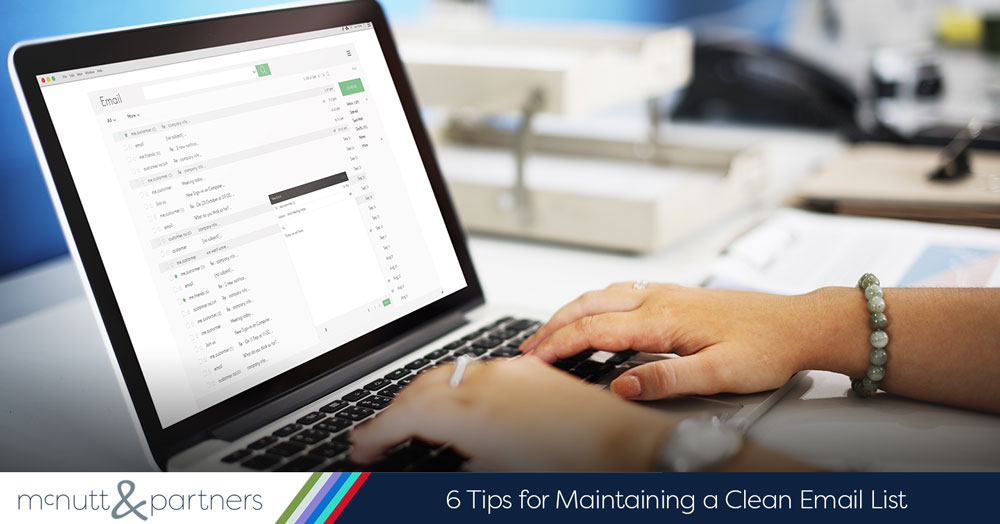Last week, we talked about how to build your business’ email list from the ground up—and the importance of doing so with email being an established staple of digital communication. Once you have a solid email list established, you should not simply put it on autopilot. Maintaining a clean email list is not only beneficial for your own organization and peace of mind, but it can also save you time and money by helping you avoid pouring your resources into dead end leads.
People change over time, and so do their email addresses. A list that you thought was once full of fruitful leads could prove less than so, which you will only know from doing proper maintenance. When you have a good feel for the current state of your email list, it will help you decide the best means for keeping it productive and growing.
Check out these six tips for maintaining a clean email list.
- Routinely check for errors and typos. One of the key words in the phrase “maintaining a clean email list” is the word “clean.” When curating an email list for your business, it’s important to initially proofread it to check for simple errors like misspellings and typos (Ex: johndoe@gmial.com; janedoe@alo.com.) As you acquire more email addresses, regularly check over your list for easily-corrected errors. Many email marketing services have built-in maintenance tools to check for inaccuracies like these.
- Manage bounces and bad email addresses. Despite your maintenance efforts, it’s inevitable that some email addresses will go “bad” over time. Some people may shut down the email accounts, others may change jobs from where their emails were hosted and still others may abandon an email account until the inbox fills up and it can no longer accept messages. When you attempt to send an email to a bad/invalid email address, the response is registered as a “bounce.” A high bounce rate can negatively affect your sender reputation by lumping you into the spam category. Pruning your list regularly by eliminating bounced addresses will show that you are not a spammer (who typically does not want to devote the time and resources to the pruning process). In maintaining a clean email list, most senders suggest a threshold of three to five bounces before removing an address from your list. That’s because one bounce could have stemmed from someone not cleaning out his or her email address, or technical difficulties, for example.
- Monitor feedback loops. Sometimes, rather than opt out of your email list, people find it easier to just report your unwanted messages as spam instead—even if they opted in in the first place. By monitoring feedback loops, you can identify people who report you as spam unwarrantedly and remove them from your lists so it does not hurt your sender reputation.
- Address inactive or low-activity users. Though it does not cost more to send to send to inactive users, continuing to do so can affect your sender reputation score. It may seem counterintuitive to remove addresses from your list who have not actively opted out, but doing so can ultimately benefit you in the long run by keeping you out of the spam category. Determine what you consider low activity to warrant someone getting removed from your list. This will depend on how often you send out emails, and how often that user opens them. This measure of low activity is up to you. Group these low-activity or inactive users together, and before removing them, give them incentive to stay (see next tip).
- Start a re-engagement campaign. Take your list of low-activity or inactive subscribers and send them an email encouraging them to become active again. Re-engagement tactics could include giving them time-based offers (“It’s your last chance for…”), asking them to confirm their subscription or asking them to update their profile to continue to receive your information and exclusive offers. If these strategies don’t work, simply ask them if they want to remain on your list, and include an easy way for them to opt out if not. If the subscriber remains inactive, remove the subscriber from your list.
- Make adjustments as needed. Your email list should be treated as a constantly-evolving entity. It’s there as a tool to help you connect with your brand’s followers, so tweak it as needed in order to keep it healthy and growing. When maintaining a clean email list, remember—its success should not be measured by the number of subscribers you have, but by the quality of subscribers you keep.
Need help maintaining your email list and making it work to your brand’s advantage? Contact the McNutt & Partners team today at 334-521-1010 or visit our contact page.


P.S. Keeping your email list clean keeps you “in the clear” with regard to federal anti-spam regulations, and keeps you in your email provider’s good graces. In addition to these useful tips, we can help you keep a close eye on list member feedback, both positive and negative, to ensure you have your finger on the pulse of your audience.
– James M. Joyce, Technology Partner